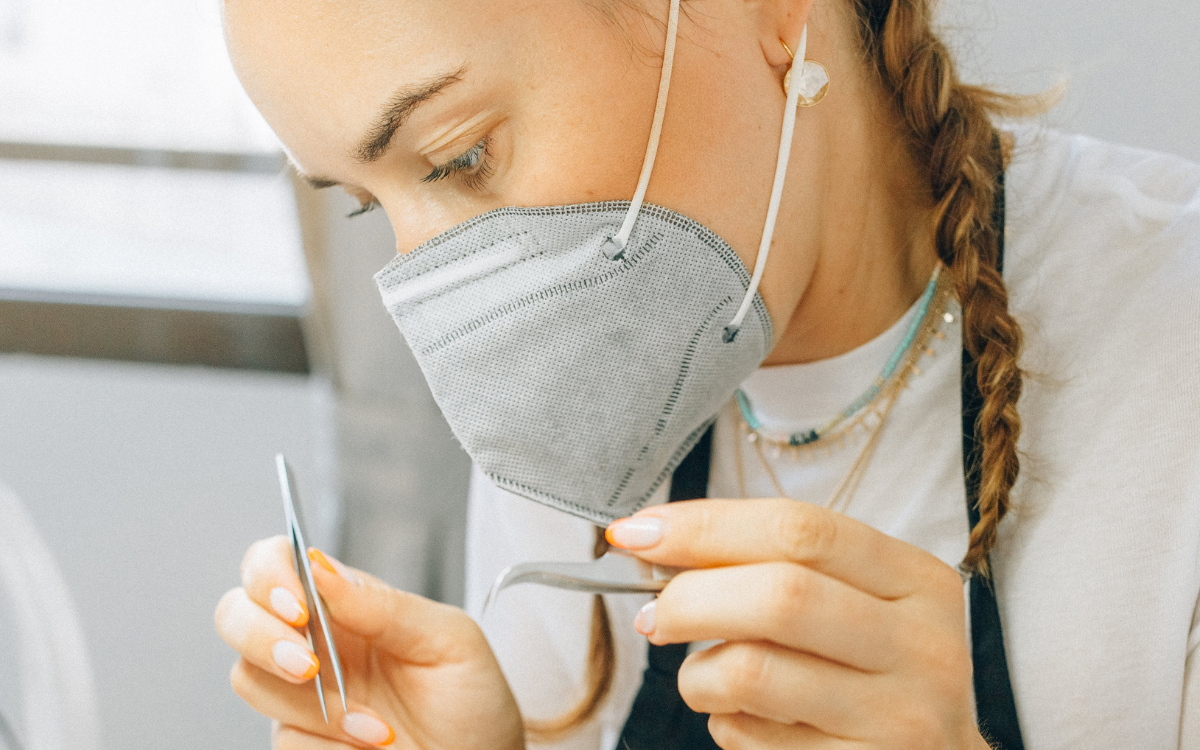When you operate a company, engaging with influential people in your community can be an effective and, in many cases, more cost-efficient approach to bringing your work to a larger audience. You offer complimentary eyelash extension services to a local celebrity or influencer or even to a friend who has a large number of followers on social media, and in exchange, they give you a shout-out on social media, a blog article about their experience with lash extensions, or photo content for your website. If all goes according to plan, new followers, and even better, new customers, will pour in. However, if you've never organized a collaboration before, the process can feel quite overwhelming. Who do you ask? How do you ask? What happens after you've asked? As a result, we have compiled a few pointers that will assist you in successfully planning a social media collaboration to broaden your audience reach and convert an influencer's following into new consumers for your business.
If you're reading this, you might already be thinking of the ideal person to work with on this project, which is fantastic! You've made it through the halfway point! Nevertheless, before finalizing the partnership with your influencer, a few prerequisites must be met, regardless of whether or not your search is complete.
1. Positioning
When selecting an influencer for your collaboration, location is paramount. If you own a lash business in Las Vegas, you probably won't want to hire a co-collaborator whose audience is located in Toronto. This is because Toronto is a very competitive market. Choose someone with a fan base in your city or nearby so that the content they produce can reach people who live close enough to use your service.
2. the number of followers
When selecting an influencer, size isn't always a positive quality indicator. Choose a collaborator with a similar reach, especially when starting. For example, if you have 2,000 followers, you might have more success working with someone between 1,000 and 5,000 followers rather than someone between 60,000 and 100,000 followers.
3. Interests, as well as the many kinds of followers
Make sure that the person you choose is consistent with the image of your company. Remember that this individual is functioning as an ambassador for your brand, and they should be someone that you feel proud representing you. Not only is it important for your cooperation to resonate with both of your audiences, but you also want this person to be someone that you are proud to have represent you. This means selecting someone whose beliefs are congruent with those of your business and whose clientele is likely to be interested in eyelash extensions. Bloggers focusing on fashion and beauty, makeup artists, and models local to your area are all wonderful places to start.
4. Sense of beauty
If you plan to receive photo content from your co-collaborator, you should be careful to find someone whose aesthetic aligns with your company's. Please take note of the photo editing techniques they use, the hues they go toward, and their overall aesthetic. You want to share the information they develop for you on your wall and possibly your website, so make sure it will sync with what you have planned.
5. You could also ask a friend!
If this is your first time working with another person, it's best to keep things straightforward. Inquire about her interest in participating in a little shoot with a buddy who is a cosmetics artist. You will lash the model, and she will do her makeup. At the end of the shoot, you will have cross-promotion from each other's social media accounts and photo content for Instagram, Facebook, and your website!
Once you've decided on a friend or influencer to work with, it's time to approach them with your partnership idea! But remember...
6. Approach in a businesslike manner.
Instead of sending a message to a potential partner on Facebook or Instagram, you should try to contact them by email if possible. This demonstrates that you professionally conduct business and assures they won't forget to include you in their message requests.
7. Be explicit about what you anticipate from others.
This is the golden rule when it comes to collaborations. There is no tried-and-true method for forming partnerships with influential bloggers and other online voices. In light of this, you and your collaborator have much leeway to devise a working arrangement for your collaboration that will satisfy both of your needs. This also means that you must be very explicit about your expectations of others.
Make sure you take into consideration the following while you are organizing your partnership:
- The kind of operating system that is currently installed. Are they putting together a post for Instagram, an Instagram story, a post for Facebook, a blog piece, or photographs for the web?
- The number of postings they will create and the time frame they will post those messages.
- What does the format of the content need to be? You might want to snap their picture at the beach with the ocean in the background because they are going on a trip. Or perhaps you don't care which selfie you post as long as it highlights your lashes. The person you're working with may have a very particular aesthetic and even particular depths that they work within their photographs; therefore, you should ensure that you reach an agreement on the material upfront so that nobody is let down.
- Whether or whether there is a monetary transaction involved or whether it is only an exchange of services.
8. Write up a contract.
Even while it might sound a little dramatic, this is, after all, a business transaction. Get everything in writing as soon as you and your collaborator agree on the parameters. Both of you will be held more accountable because of this, and once the collaboration is complete, you can use the contract as a basis for future collaborations. Were there any provisions of the contract that became problematic in the end? Were there some aspects that weren't clear? No problem! You are now aware of what you should change for the next time.
It is necessary to keep track of your results. Have you gotten more people to follow you? By how many? And maybe, most importantly, did any of those leads become new customers? If the partnership is successful and you see a rise in bookings, you should think about working with this influencer once more shortly. If this is not the case, investigate what might have gone wrong and try again with a different person who might be a better fit.
9. Provide them with a discount code.
You can easily track the number of new clients you gain by providing your influencers with a promo code to hand out to their audiences and a deadline for redeeming the voucher within a certain amount. You'll know that a consumer came to you due to your collaboration whenever they come in with that code at your business. You won't have to sit around for months wondering if the collaboration was worth it because the coupon expires.
10. Obtain a report on it.
Request that your influencer provide you with a report detailing the number of likes, comments, and views their material garnered after the collaboration. This won't necessarily be the ideal way to judge success, but it will help you determine how receptive their audience was to the content presented to them.
What exactly does it mean to collaborate as a team in the workplace?
Collaboration among members of a team is essential to the development of synergy within that team. This is because collaborative teams collaborate to generate new ideas, share expertise, and finish ambitious projects. To put it another way, a team that collaborates well is one that, as a whole, can do more than the sum of its individual members' capabilities.
Collaboration on teams in the workplace can take on a variety of forms, depending on the roles that individuals play:
When you collaborate as a team, it's easier to divide up the work in a way that will let your direct reports shine, enhance their skill sets, and help them advance their careers. This is especially helpful for team leaders.
As an individual who contributes to a team, collaboration enables you to improve the effectiveness of your communication and work together to achieve the team's goals.
Working together as a team is essential for ensuring that work is completed promptly for cross-functional collaborators. Your team runs the risk of becoming siloed if there are no obvious means for them to collaborate and interact with one another, and as a result, work may end up being lost.
What does it look like when people work together effectively?
The following are a few illustrations of how employees might collaborate.
- The best way to illustrate how productive teamwork can be is to look at a good old-fashioned brainstorming session that a group conducts. Through participation in this activity, every team member can offer their thoughts and help advance the project by coming up with original answers to difficult questions.
- Diverse teams have members from various backgrounds, and each group member offers something special. Your team's ability to collaborate will improve if you create diverse teams with members with various skills, experience levels, and backgrounds (personal and professional).
- Honest communication and open debates: For teams to work together efficiently, individuals on those teams must be willing to question one another, delve deeper into particular areas, and even argue to move the job ahead. Being a collaborative team means co-creating to build better solutions, listening to input from other team members, and working together to achieve your goals. Open and honest communication isn't always the easiest—or most comfortable—thing to do, but it is essential to being a collaborative team.
Core Principles of Effective Teams
The following principles are essential to the success of collaborative teams:
- Clarity: The ability to communicate is essential. It would be best if you properly communicated perspectives, ideas, and priorities to avoid needless confrontations or misunderstandings. This is true even though your team may not completely agree on everything.
- It is not necessarily the case that the amount of time a team spends together directly correlates to the degree to which they collaborate. How one spends their time is of the utmost importance. Meetings and reports should be kept brief and get straight to the point to assist your teammates in completing their deadlines.
- On a positive note: not all group initiatives will go off without a hitch. Teams that can bounce back from setbacks and approach new endeavors with a positive mentality are more likely to find long-term success in their collaborative efforts.
- Trust is essential if you want your team members to feel comfortable sharing their ideas and one-of-a-kind abilities. Make it clear to your team members that you have their best interests in mind and faith in their talents.
- Accountability: Check in with your team and make sure that everyone is holding themselves accountable for their work. If someone on your team is missing deadlines or not providing the quality of work expected of them, you should strive to discover the issue and support them so that they can meet their goals in the future.
Remembering that a project's performance can be improved by having a varied workforce is important. It's nice to have a variety of personalities and skill levels on a team, but productive collaboration can only happen when every group member subscribes to these principles.
Three ways to improve teamwork
Okay, so you want to form a cohesive unit; what should you do now? There is no "on" or "off" button for improving teamwork; rather, it is a talent in project management that requires consistent attention and practice. But if you're ready to enjoy the fruits of teamwork, here are three suggestions to foster a cooperative atmosphere in your workplace:
1. Encourage people to work together.
Although it may seem apparent, it is essential to demonstrate that you and your team value working together. However, not all teams emphasize working together; some are fueled more by healthy rivalry than a desire to succeed. It's crucial to emphasize teamwork's significance and to devise a plan for getting there.
2. Establish norms for how you'll be communicating.
Guidelines for team communication and collaboration are important to building and improving teamwork. Keep in mind that working together won't come easily at first. Team members will need time to get to know one another, and that's perfectly okay. But if you and your team take the time to sit down and work on a communication strategy together, you can streamline the process.
3. Solicit contributions from others.
The fundamental principle of teamwork is that collective effort yields superior results to individual effort. Therefore, inviting co-creation is one of the finest strategies to encourage team collaboration. Instead of simply ordering your team to collaborate, try holding brainstorming sessions full of open dialogue and respectful disagreement. When people engage in co-creation, they work together to construct an idea rather than individually pursuing a common objective.
Collaboration doesn't have to happen in person. There is much potential in asynchronously doing brainstorming sessions. The members of a distributed team can easily build upon each other's work by sharing and editing a single Google Doc.
10 Tips for Better Collaborations
It doesn't matter if you're a creative freelancer or the leader of a new start-up company; there are many compelling reasons to participate in collaborative projects. To facilitate an effective partnership, we have a few pointers up our sleeve that you should keep in mind.
What exactly are the benefits of working together? You'll get to know interesting new people, expand your horizons, become more creative, acquire useful new skills, and generate excellent work—all while having a good time!
Working alone, regardless of how soothing you believe it may be, can lead your workflow to become stagnant, and it also means that you will not excel at the same rate as you would while working with others. Working alone has been associated with negative mental health indicators and a diminished passion for work.
It doesn't matter if this is your first time working with others in a professional setting or if you're a seasoned pro with a vast network; you may likely benefit from some additional direction. Without further ado, here are ten simple pointers for collaborating that you can practice immediately to make your collaborations more successful.
1. Working together to create something will help you produce greater results.
People who have never worked together on a project sometimes harbor the irrational fear that their contributions will go unnoticed or that their ideas will be taken without credit. Collaborating with other individuals will enable you to generate better ideas, produce better work, and develop your creative abilities.
People who collaborate on a project in a group have been shown to generate higher-quality work and complete it more quickly than those working on an identical activity in isolation. Refer to point 10 if you want to avoid having your work taken without your permission or without receiving recognition for it.
2. Take caution in the selection of your team.
When searching for people to work with on a project, it is only natural to be drawn to those who share your values and perspectives. It's easy to relax, and you have confidence that you'll get along well with them.
However, the most effective teams include members with various backgrounds and perspectives.
Make sure to include a variety of sexes, personalities (extroverts and introverts), artistic movements, and musical genres in your selections. Mixed teams consistently achieve greater results and perform better overall. You can expect a variety of unique viewpoints, and nobody will contribute the same old ideas; rather, everyone will bring something fresh to the discussion.
3. Working together requires pooling the expertise of many individuals.
If one team member is more straightforward than the others, it may be simple for that individual to seize control of the situation and begin making decisions on behalf of the rest of the group. You should do all in your power to avoid doing this.
The best part about working together on a project is hearing everyone's ideas and input on how to improve it. Everyone on your team, including the more reserved members, should have the opportunity to share their thoughts and opinions.
Exhibit some decency, and allow others to express themselves.
4. Plan
Do not begin working together unless you know what you intend to accomplish first. Gather all of your team members in one place, and discuss what the project will entail, what will be produced (the end product), and what the ultimate result will be.
Establish a timeframe for the project and dates for when different parts need to be finished. This guarantees everyone is on the same page regarding the project and working towards the same objectives.
Some creative endeavors will not profit from such a tight structure; in these cases, allowing the ideas to come to you more organically is advisable.
5. Accept the responsibility.
When people work in different time zones or locations, it can be challenging to find a time that works for everyone to get together and participate in a project.
Because of this, you might have to get up early or stay up quite late to communicate with people living in other countries. However, despite the additional time and effort you will require, the results will be well worth it.
Ensure that every member of your team is enthusiastic about the project. They have to be on board with the project's aims and objectives for the work to be successful; otherwise, it will suffer. Everyone will have to challenge themselves to produce excellent work, but in the end, it will be worth the effort.
6. Get out of your ivory tower.
It should come as no surprise that collaboration involves working with other individuals. And by this, we do not mean ordering other people around and boosting your ego in any way, shape, or form.
You must be willing to consider the opinions of others, allow them to share their thoughts, and seek feedback on your concepts. Remember to remain modest and acknowledge that someone else may have a better idea than you have. To be successful, cultivate relationships with everyone you collaborate with.
If the thought of working with other people to realize your visions is what you have in mind when you hear the word "collaboration," then you should go elsewhere.
7. Get through the starting blocks successfully.
Your first requirement for a project is an idea of what you want to create. When you have that, the next step is to look for a solid team that will assist you in developing the idea and getting the project off the ground. Ensure that your entire staff is fully committed to the project.
Look online for free tools that can assist you in working together; plenty of options are available, from communication technologies like Skype and Slack to tools for project management like Asana and Trello and everything in between. Remember the obvious ones, like Google Docs and Dropbox, and don't forget them!
8. Sometimes, you won't all be on the same page.
Be ready for people to disagree with you. If something like this occurs, it does not necessarily indicate that your project is failing.
Different points of view are beneficial since doing so compels you to examine and possibly modify your thinking. This does not imply that you are required to make concessions. Pay attention to the points of view of everyone, have an open mind, let go of ideas that aren't producing results, and, most importantly, show respect.
There is no way to avoid criticism, so you might as well learn to embrace it. Discuss your disagreements and learn how to give each other constructive criticism; nevertheless, you should never become upset or make it personal.
When you are all putting your names on a project, you must ensure everyone is satisfied.
9. Don't forget any of the specifics.
Remember to include essential particulars like a timetable, a budget, and a profit-sharing arrangement.
Confirm these particulars before beginning work on a project; the last thing you want to do is start deciding how the earnings will be split up when the project is nearly finished.
Making all the essential decisions at the beginning of the process will clear the way for your team to concentrate solely on the creative process without interruptions.
10. Make a contract
This is perhaps the most important piece of advice regarding working together.
Simply because you have a written agreement with your teammates does not mean you distrust them. It simply indicates that you have set on paper what you intend to achieve, how things will be handled, and what you will do if your original plan needs to be altered.
Having these things written down is beneficial in case you need to refer back to them later. Even though it is unlikely that you would use it, it is still a good idea to have a backup plan.
Your contract should include pertinent information such as how profits will be split and who will receive credit for what. It doesn't need to be lengthy or filled with legal language.
Final Thoughts
Now that your tweezer case is brimming with ideas, it's time to start collaborating. Your collaboration can broaden your audience, catapult your follower count, and, most importantly, convert your new followers into paying customers if you properly prepare for it and select the appropriate influencer.







